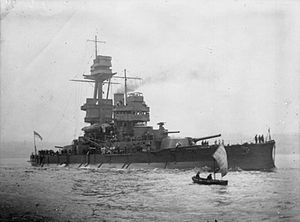HNoMS Bjørgvin

| |
| Career | |
|---|---|
| Ordered: | 1912 |
| Laid down: | 1912 |
| Launched: | 1913 |
| Commissioned: | Never commissioned by the Royal Norwegian Navy, compulsory purchased by the Royal Navy during WW1 |
| Fate: | Accidentally blew up in September 1918 |
| General characteristics | |
| Displacement: | 4,900 tons |
| Dimensions: | 94 m ( ft) x 16.8 m ( ft) x 5.4 m ( ft) |
| Armament: | 2 x 24 cm (9.45 inch) guns 4 x 15 cm (5.90 inch) guns 6 x 10 cm (3.94 inch) guns 2 x submerged torpedo tubes |
| Aircraft: | none |
| Propulsion: | 4,000 hp (2,982.8 Kw), 15 knots (27.8 km/h, 17.3 mph) |
| Crew: | 305 |
HNoMS Bjørgvin, which would have been known in Norway as P/S Bjørgvin (where P/S stands for Panserskip - litt.: armoured ship) was the lead ship in her class. She and her sistership Nidaros was ordered by Norway in 1912 to supplement the older Eidsvold class and Tordenskjold class coastal battleships. The two ships laid down were requisitioned by the Royal Navy when World War I broke out and classified as monitors.
Description and fate
With heavier main guns than the previous Eidvold class and Tordenskjold class battleships, and her secondary armament in turrets instead of in a battery, the Bjørgvin would have given a significant boost to Norwegian naval power. When WW1 broke out however, the Royal Navy requisitioned most warships being built in Britain for foreign powers and pressed them into service. The British government paid Norway £370,000 as compensation. The Bjørgvin was renamed HMS Glatton and classified as a monitor. She caught fire and exploded on 16 September 1918 at Dover, shortly after being commissioned. While the cause of the fire was unclear, it was speculated that the insulation of one of the midships magazines was somehow ignited.[1]
Notes
- ^ Explosions in Warships During the War, extracted from CB 1515 (24) The Technical History and Index, Volume 2, Part 24 "Storage and Handling of Explosives in Warships" (October, 1919). Retrieved 11 December 2005
